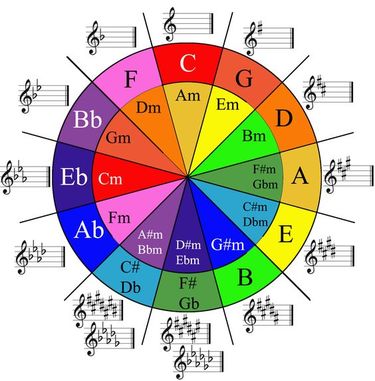|
At some point in a musician’s life, the Circle of Fifths are introduced either at a music lesson, music theory class, or just out of necessity. During my early learning years, the Circle of Fifths was explained to me by several music teachers but for some reason I never grasped the full concept until out of necessity. A need to learn the Circle of Fifths cropped up shortly after an embarrassing moment during a jazz ensemble rehearsal when one of the musicians said “hey, let’s take if from the top in the key of ‘B flat minor’ rather than ‘B minor’. WHAT, oh no, think-think, how many flats are in the key of B flat minor? Thank goodness, I was able to wing it and simplified my part to half notes and a bunch of rests. It was definitely time to re-visit the Circle of Fifths again! How I use the Circle of Fifths There are numerous uses and in-depth music theory explanations about the Circle of Fifths, but for me the Circle of Fifths comes in most handy as a quick reference guide for key signatures. To back up a bit: The Circle of Fifths is a visual tool to help understand the relationship between major and minor keys. If you memorize the chart or have a copy handy, you can easily figure out how many sharps or flats are in a particular key. Example of Quick Referencing To know how many flats or sharps are in the key of ‘B flat minor', simply find Bbm (aka B flat minor) on the chart, and wha-la, you can either play with 7 sharps or 5 flats (your choice, it produces the same notes). Okay let’s try something else: You are playing a piece of music with 3 sharps but not sure which key you are in. Quickly find the music staff with 3 sharps and there you go, you are either playing in A major or F# minor (note: F#m and Gbm are the same key). More Uses Knowing how to read the Circle of Fifths will help you recognize the relationship between major keys and their relative minor keys. A major key and its minor partner (outside circle = major, and inside circle = minor) uses the same sharps (indicated as #) and flats (shown as b) in their key signature or scale. Example: Find D major (D in the outside circle). D major’s relative minor key is B minor (Bm). They both use 2 sharps. Coolness! Here are a few more tips:
I hope that helps and gets you started! If you're ready to learn more in-depth uses, there are plenty of music theory books and information available. If you find the chart challenging to memorize, no worries, just click on the Download File below.
“Inside the Circle of Fifths” author: Suzy, violinist and founder of Vogue Violin www.vogueviolin.com
0 Comments
Leave a Reply. |
|||||||


